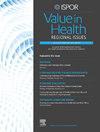孟加拉版冠心病患者健康相关生活质量问卷的验证
IF 1.4
Q3 HEALTH CARE SCIENCES & SERVICES
引用次数: 0
摘要
目的评估孟加拉语版心脏质量问卷(一种核心的心脏病健康相关生活质量(HRQoL)工具)的心理测量特性,特别是在冠心病(CHD)患者中。方法将英文《心脏质量报告》翻译成孟加拉语,在孟加拉国2家心脏专科医院进行横断面和复试研究。所有在2019年4月至10月期间接受经皮冠状动脉介入治疗或冠状动脉旁路移植术并诊断为冠心病的患者均符合招募条件。出院前后分别进行孟加拉心脏qol、EQ-5D-3L、PHQ-9和GAD-7问卷调查。评估孟加拉心脏生活质量量表的因素结构、内部一致性和结构效度。结果共纳入945例冠心病患者,其中198例患者提供复检数据。Mokken量表分析支持孟加拉语HeartQoL问卷的2因素结构(生理/心理分量表)。虽然没有观察到下限效应,但有一些证据表明16.1%的患者在HeartQoL情绪分量表上存在上限效应。孟加拉心脏质量问卷显示出令人满意的内部一致性(Cronbach 's alpha >;0.75)、判别效度(健康状况较差的患者得分较低)和对变化的反应性(效应量为0.23至0.68)。结论孟加拉心脏生活质量问卷是衡量冠心病患者HRQoL的有效、可靠和有效的方法。然而,未来的研究需要围绕其使用,特别是在其潜在的文化敏感性方面。本文章由计算机程序翻译,如有差异,请以英文原文为准。
Validation of the Bangla Version of the HeartQoL Health-Related Quality-of-Life Questionnaire for Patients With Coronary Heart Disease in Bangladesh
Objectives
To evaluate the psychometric properties of the Bangla version of the HeartQoL questionnaire, a core heart disease health-related quality-of-life (HRQoL) instrument, specifically in coronary heart disease (CHD) patients.
Methods
The English HeartQoL was translated into Bangla and then a cross-sectional and a test-retest study was undertaken in 2 specialized cardiac hospitals in Bangladesh. All patients admitted for percutaneous coronary intervention or coronary artery bypass graft between April and October 2019 and diagnosed with CHD were eligible for recruitment. The Bangla HeartQoL, EQ-5D-3L, PHQ-9, and GAD-7 questionnaires were administered before and after discharge. Factor structure, internal consistency, and construct validity of Bangla HeartQoL were assessed.
Results
A total of 945 patients with CHD were enrolled with a subgroup of 198 patients providing test-retest data. Mokken scale analysis supported the 2-factor structure (physical/mental subscales) of the HeartQoL Bangla questionnaire. Although no floor effects were observed, there was some evidence of a ceiling effect on the HeartQoL emotional subscale in 16.1% of patients. The Bangla HeartQoL questionnaire demonstrated satisfactory internal consistency (Cronbach’s alpha > 0.75), discriminative validity (lower scores in patients with poorer health), and responsiveness to change (effect sizes of 0.23 to 0.68).
Conclusions
The Bangla HeartQoL questionnaire was found to be a valid, reliable, and responsive measure of HRQoL in CHD patients. However, future research is needed around its use, particularly in terms of its potential cultural sensitivity.
求助全文
通过发布文献求助,成功后即可免费获取论文全文。
去求助
来源期刊

Value in health regional issues
Pharmacology, Toxicology and Pharmaceutics-Pharmacology, Toxicology and Pharmaceutics (miscellaneous)
CiteScore
2.60
自引率
5.00%
发文量
127
 求助内容:
求助内容: 应助结果提醒方式:
应助结果提醒方式:


